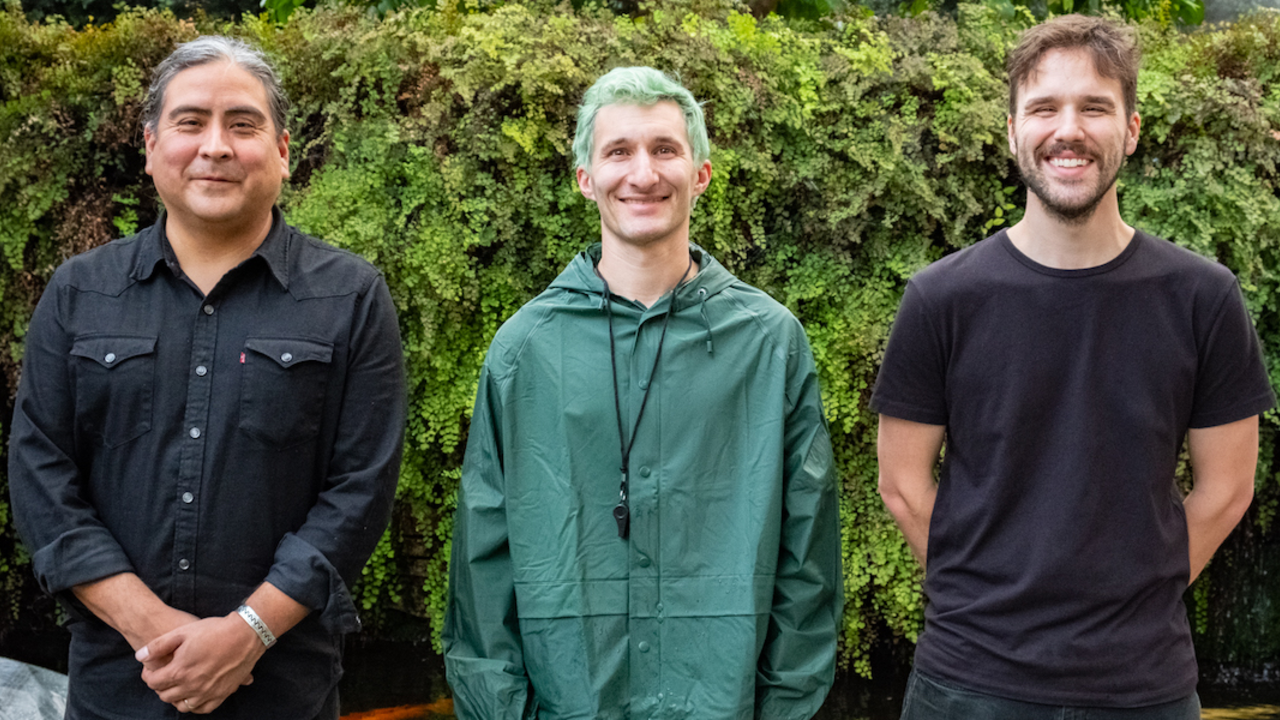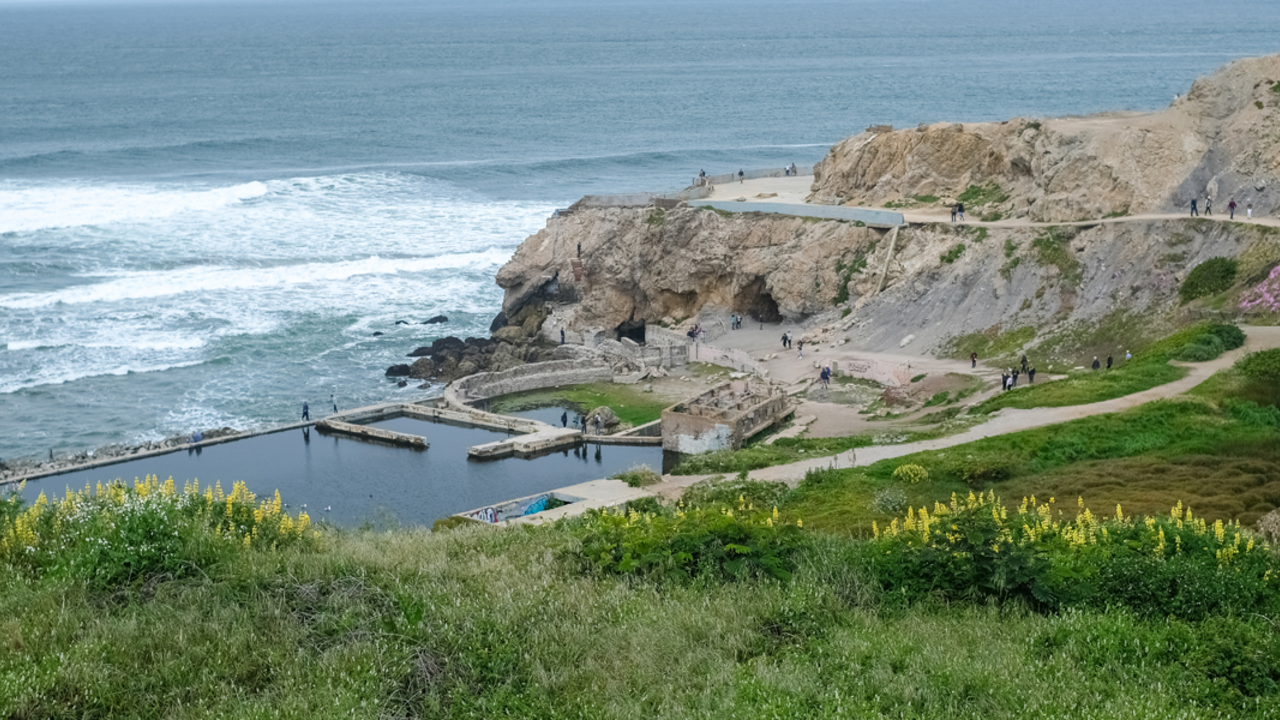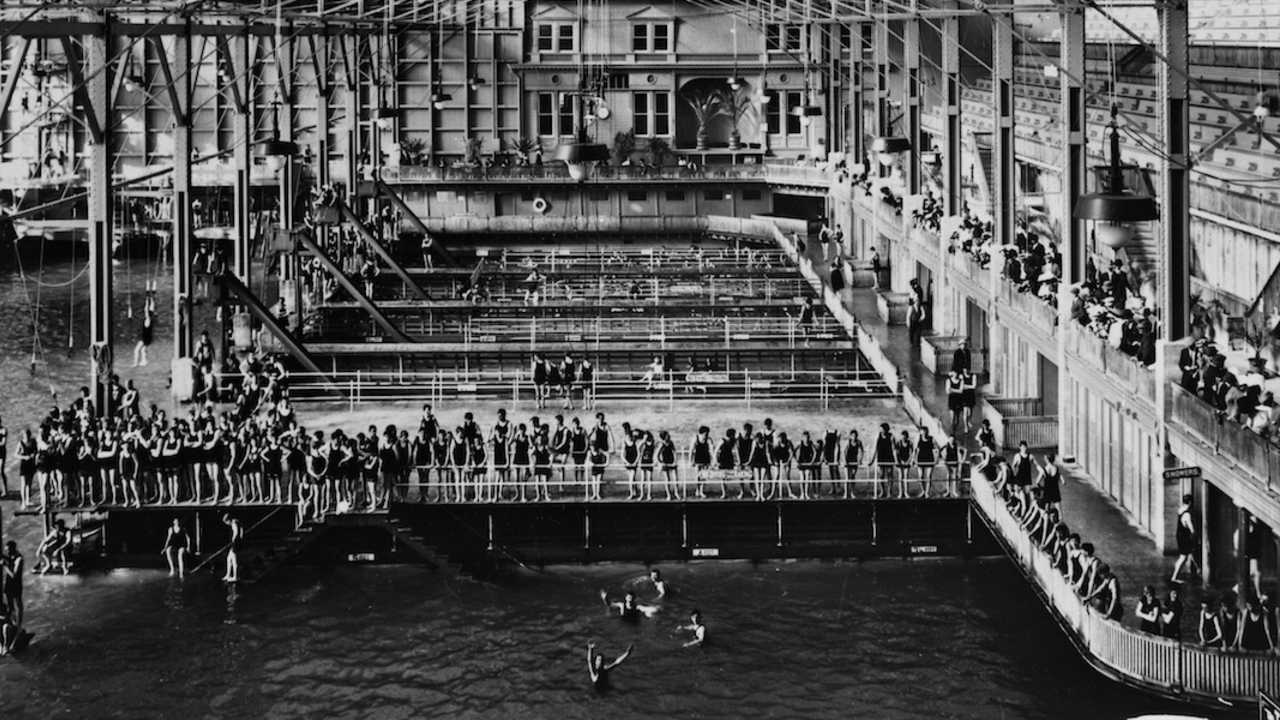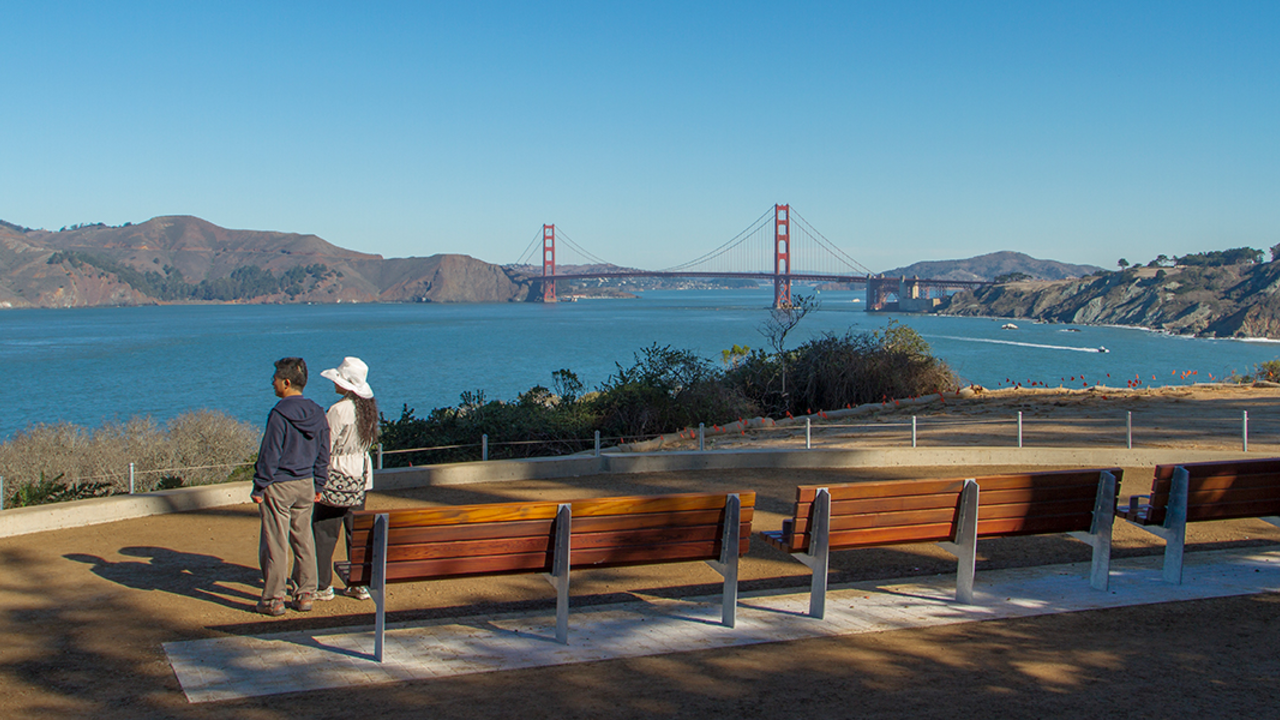Artist Raven Chacon Q&A: Insights on sound and landscapes

Courtesy Trista Dymond
By Jainita Patel and Yakuta Poonawalla
San Francisco Park Stewardship
“The sound that I want to hear is the only thing I really trust in myself, what it is and where it wants to go….”
Raven Chacon is a composer and artist who works primarily with experimental sound. A former member of the American Indian art collective Postcommodity, Chacon has a long career as a composer, collaborating with sound artists in his home in Albuquerque, N.M., and in the Bay Area. Chacon explores the intricacy of noises that make up the world around us and brings attention to different ways sounds can tell a story. He is a renowned Navajo artist who is also a teacher at the Native American Composer Apprenticeship Project (NACAP), where he mentors up to a dozen students a year in classical and chamber music.
Now Chacon, in collaboration with The Living Earth Show, is bringing his latest work to Lands End. Tremble Staves is a 70-minute performance at Sutro Baths on October 19. Chacon and The Living Earth Show will use water as an instrument to illuminate its role in our lives.
We had a chance to sit down for a Q&A with Chacon:
Can you share a little bit about yourself and your work?
I grew up here on the Navajo reservation. Later on, the family moved to Albuquerque, New Mexico, and it was there that I had the opportunity to take piano lessons and to learn more about music theory and performance. I guess in a way I was kind of forced to take piano lessons, but I loved it. I didn’t stick with the piano for too long. I ended up learning the guitar and wanted to learn other instruments, teaching myself how to play, trying to play other chamber instruments, because I already had the basis of already being able to read music with the piano lessons. Later, I began experimenting with performance and building instruments and recording sounds any way I could. This eventually led me to want to study music in the university.
Much of my work involves writing music for other people who play the so-called classical instruments or who read music notation. Another part is performing and improvising music, building instruments or playing nontraditional instruments. This can involve people who don’t read music notation or aren’t classically trained, but still are nonetheless quite capable musicians and improvisors themselves. A third thing came about from these improvisations and that was making installations or artworks that used sound as the vehicle for their concept or the mode of telling a story, but they don’t exist as a recording or a performance or music composition, they might exist as something more suited to an art museum, something maybe presented as something without a duration, maybe using a room more as an instrument rather than anybody in particular playing the sounds. These are three separate modes that I work in and keep separate in a lot of ways. I go and write a piece, for instance, with The Living Earth Show who are also performers that are interested in multi-medium presentations of how they show their work; they might incorporate costuming, video and dance. But it can be rare occasion that these things might be integrated into the chamber works that I compose.
What made you choose Sutro Baths as a backdrop for your piece?
In the very beginning of deciding to collaborate, we were starting to think of instruments and sounds and ways to use water as a percussive instrument. I know a lot of the time water gets used as dripping sounds and usually with the purpose of representing the natural world untouched by humans, but I was trying to imagine water being slapped or maybe hit with drumsticks, the interaction with the human body. Very percussive, something not necessarily associated with music made from water sounds. In thinking that through with Andy and Travis (Andy Meyerson and Travis Andrews of The Living Earth Show), I started thinking that we’ll probably need water if we do this. Would this be indoors or outdoors? We also started to think about why to speak about water and our relationships to water. The two of them, living in the SF Bay Area, are surrounded by water and myself most of the time living in a desert, water is very rare and it’s something that I don’t feel has ever been taken for granted in the desert. We started talking about our relationship to water, and realized that it is now becoming a global idea that water cannot be taken for granted, that it has become a scarcity.
We started thinking of sites to do this work and decided how it would respond to water and sound. We started thinking of bodies of water, either in motion or still, static, stagnant and thinking of those as maybe representations of the music: is the music going to be in motion or is it going to sound like it’s staying still? Really, thinking of all the ways water could be a metaphor for the music we were coming up with. It also had to do with the importance of who we make this work for and who can access it. A lot of the time, chamber music and music made with classical instruments has a reputation of only being accessible to people who are going to go to the concert hall where this type of this music is played, to those who can buy a ticket to these places. A lot of people don’t know where those places are, they’ve never been in those buildings before. They’re afraid to even take a chance because what if they don’t like the way it sounds. We wanted to think of a place that was somewhat accessible, someplace one could go and even just sit from afar and listen if they wanted to. On that level, Sutro Baths seemed like the perfect place, or one of the few places, to do this. But even more so, upon visiting Sutro, I learned about the history of this site that was a very public place at one point in time. And even before humans it was a public place for many animals, many walks and swims and flights of life. Then being purchased and built upon to make Sutro Baths and then that kind of urge for development and overtaking the beach. And upon learning that this development ultimately led to a modern ruin, and recognizing the speed at which humanity is taking for granted its natural resources and what could be the outcome of that. So the place itself served to be a really beautiful metaphor for what we are wanting to say with this piece.
Growing up in a community that has seen a very different history and has struggled to present their identities in the dominant narratives, have you had any thoughts about that or what role you play? How do we change that people now are separate from the land?
As an indigenous artist, we are conscious that we are asked to represent that land with our art and at best, there are works that can give information about the places that we know, the long histories of what we know, the deeper stories about how the land works, how it is alive and takes care of people. When I think about the work I do with music, music is in a position where it voices sounds. It’s not always in a position to be didactic or moralizing an issue and it doesn’t have to be either. I do appreciate opportunities like this piece to see how this story can be told or how this urgent topic can be addressed by way of performance or music. If people are listening to me because I’m an indigenous person, I do recognize the responsibility I have in sharing the knowledge that I do have. I’m not from the Bay Area and there are Ohlone people or their descendants who have far more information about that place than I do. But the best I can do is talk about my relationship or travels in getting there and I tell my students that same thing. My students here on the Navajo reservation are making artwork or music that can tell about their own identity or their culture or the land that they’re coming from. I think eventually they’re going to have to find a way to share that knowledge and find links in that lineage or that relationship with the land where they’re from and exchange that knowledge with people all over the world so that they can understand the contemporary situation that we are all involved in. At best, art can start those conversations for people who are looking for answers but are not necessarily seeking to be preached to. We know we’re not living in a mode that is being beneficial to the planet, but I think what we’re trying to do is understand each other and I think art can do that in ways that other interactions might fail to do.

Is there anything specific we should be listening for when listening to Tremble Staves?
I would encourage people, if they can at the site, to walk around as they’re listening. My hope is that people will find a spot and maybe listen to one movement of the composition and then maybe walk to another side and listen from far. There will be this third character aside from The Living Earth Show who we’re going to be collaborating with, who narrates between different movements of the piece as well as telling a bit of history of the site that we’re gathering on.
What would you say is the best way to listen to your work?
In figuring out what these works are, sometimes I’ll decide that the best way to listen to them would be through recordings and that one should sit in the privacy of their own home and put on this recording and listen to it there. It has no other intended way to be listened to than as a recording. For other works, I encourage people to come to a performance because there’s a different energy when you’re listening to certain pieces of music and can see the performers creating this music. Even the sound in the space or in this case in Sutro Baths, free to the world, not bouncing off any walls or confined to headphones or speakers will have a different outcome, a different way of experiencing the music that is being projected. Sometimes, music is aligning with other things also. If Andy plays a note or rings some bells for instance and at the same time somebody’s cellphone goes off or a bird flies overhead, all of these interactions in nature are interesting when they’re interacting with music, and I believe these sounds are doing so in their own consciousness (or some other force), independent of our own intentions of what’s being activated. Other times, there are sound works that I don’t think can be performed or recorded and those are the ones that end up as installations or a video piece, or just as a score without the music, envisioning the sound in other ways, but there’s not sound to be made, just frames of reference to it.
Is there a sound in nature or in your day to day that inspires you?
Yeah, that’s funny. Sounds in nature are interesting. They’re not something I’m always conscious of. When I go on walks, I can’t say that I’m always going to listen for sounds. It’s the accidental sounds in nature, whether that nature is the forest or the desert or the city. When I hear a sound that I feel like I’ve never heard before or grabs my attention, those are the sounds I’m interested in. Those are the ones I try to memorize or record on my phone if I can. Everybody has a phone nowadays in our pockets, so you can make a video or capture a sound immediately. In the past, I’d have to walk around with a hand-held recorder 24 hours a day. Now, I try to capture it in that way, or I think about the sound and then think about how will I have Andy from Living Earth Show replicate that sound? So that is an approach to a lot of the writing that I do for instruments. That is going to lead to my experimentation for how I am going to use this cello or guitar or this percussive instrument to make the sound that I had remembered hearing a week before.
Anything else that you’d like to share?
One thing I’d like to mention is the community part of making music, especially in cities with many improvising musicians. Albuquerque and the Bay Area both have these very strong music communities that support this kind of work. I’ve been coming to the Bay Area for 20 years to perform and I have strong relationships with people and likewise reciprocate hosting when they come to my town. There are quite a few of us in New Mexico who come this way, and many from Oakland and San Francisco who come out and play in Albuquerque. This is a very tight network of people who make this kind of music and we’re just happy to share what we do with to a broader audience who may not be exposed to this kind of music outside of this event at Sutro Baths.
Talking with Chacon was an insightful and eye-opening experience that shed light on the intricacies of Tremble Staves. The parks are excited to host Chacon and the Living Earth Show at Lands End and we hope that you will join us in discovering how sound can bring us closer to some of the most valuable aspects of our existence.

